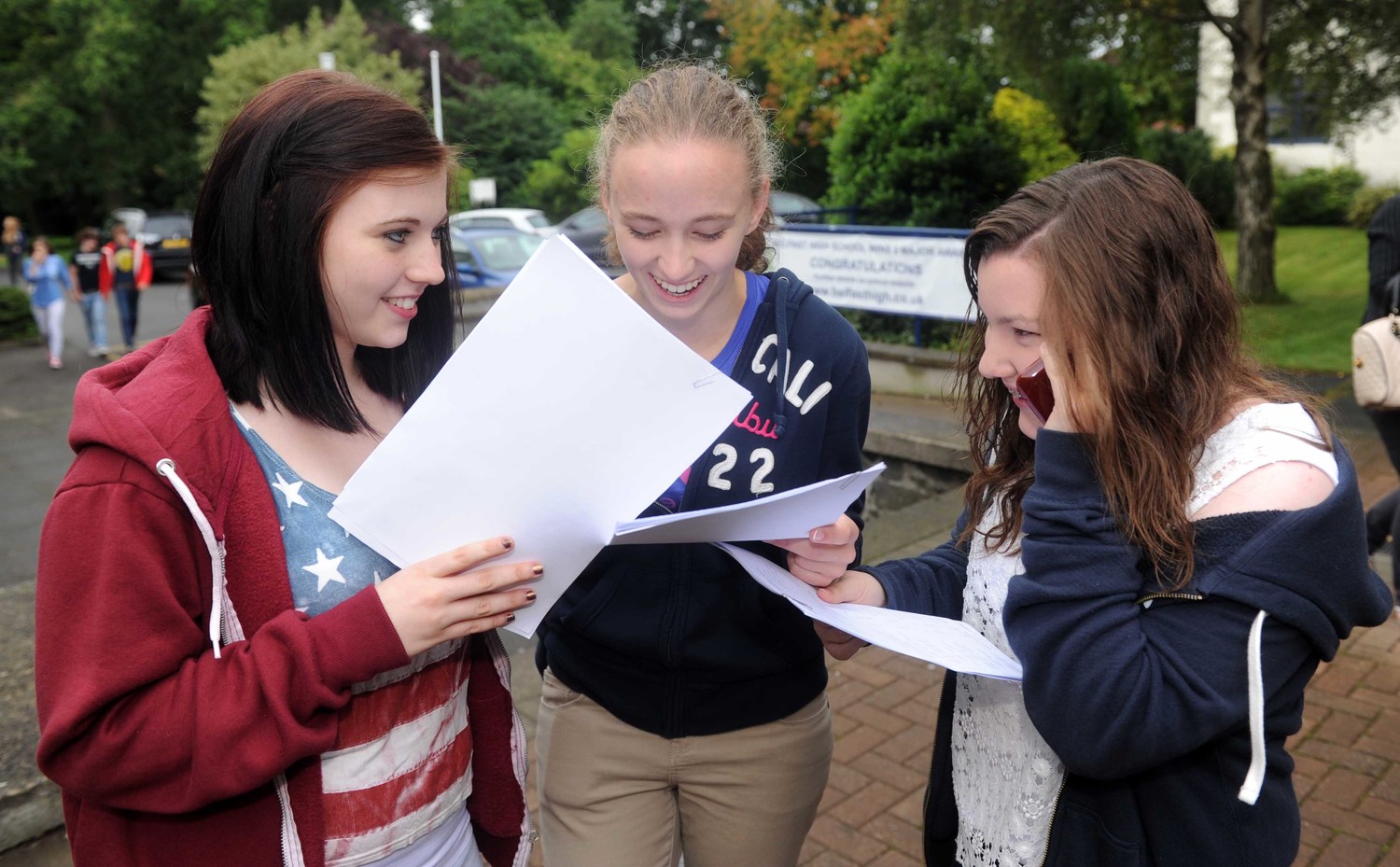View The Detail’s exam results 2012 map in a full screen map
BY KATHRYN TORNEYTHE results achieved by every grammar and secondary school in Northern Ireland in this summer’s GCSE and A-Level exams can be revealed today.
A detailed breakdown of the grades obtained by pupils attending each of the 211 schools has been released to The Detail by the Department of Education in response to a Freedom of Information request.
We have compiled an interactive map (above) which enables readers to easily access detailed data on their local schools.
A total of 21,828 pupils in Year 12 across the province were eligible for GCSE examination entry in the 2011/12 academic year – 9,194 in grammar schools and 12,634 in non-grammar schools.
Just over 12,960 pupils in Year 14 were entered for A-Level (or equivalent) examinations.
As well as a detailed breakdown of GCSE and A-Level grade achievements for each school, we also asked for information from the department on the percentage of pupils entitled to free school meals in each institution and the proportion of pupils with special educational needs.
The full data released by the Department of Education is available in an Excel spreadsheet below this article with all of the schools listed in alphabetical order.
One of our key findings is that a total of 72 schools – 34% of all of our 211 post-primary schools – failed to meet the key benchmark set in England of at least 35% of pupils achieving the basic standard of at least five GCSEs at grades A*-C, including English and Maths. They were all non-grammars.
This applied to 77 schools out of a total of 213 post-primary schools in last year’s exams. To see our detailed coverage of last year’s school results, click here.
NON-GRAMMAR SCHOOLSFree school meal (FSM) entitlement is used as a proxy measure of the levels of deprivation experienced by a school’s population. There is known to be a link between FSM entitlement and exam performance.
In the non-grammar sector FSM entitlement levels ranged in the 2011/12 school year from 4.8% at Newtownhamilton High School to 69.4% at St Gemma’s High in Belfast. Fifty-one schools had 30% or more pupils entitled to free meals and 10 had 50% or more.
For our analysis of exam performance in the non-grammar sector, we grouped the 143 non-grammar schools together according to the proportion of pupils entitled to free school meals.
Free school meals bands set by the Department of Education split schools into those with 0 – 19.99% of children entitled to free school meals, 20 – 29.99%, 30 – 39.99%, 40 – 49.99% and 50% or more.
Within each FSM band, we ranked each school’s results by looking at the percentage of pupils who achieved five or more GCSEs at A*-C, including English and Maths.
This meant we were comparing GCSE results of schools with similar characteristics.
To see our tables, click here.
Both the High School in Ballynahinch and St Killian’s College in Ballymena had around 14% of their pupils entitled to free school meals (FSM) but almost 70% of the St Killian’s pupils achieved five or more good GCSEs including English and Maths – compared to 15.3% of the Ballynahinch pupils.
Almost 22% of pupils at St Patrick’s High in Lisburn were entitled to free meals – 64% of the Year 12 pupils achieved five or more good GCSEs including English and Maths. This compares to a FSM level of 22% at Priory College in Holywood where only 15% of pupils achieved this academic standard.
Almost 64% of Year 12 students at St Joseph’s High in Crossmaglen achieved five or more GCSEs A*-C including English and Maths (FSM level of 39%) compared to 15% of pupils at Dundonald High School (FSM also 39%).
Half of the GCSE pupils at St Eugene’s High in Castlederg achieved five good GCSEs including English and maths (49% FSM) compared to a quarter of pupils at Our Lady of Mercy Girls’ School in Belfast where 48% of pupils were entitled to free meals.
A third (34%) of pupils at St Colm’s High in Belfast achieved this academic standard – despite almost 56% of pupil being entitled to free meals. This contrasts with Orangefield High School in Belfast (55% FSM) where less than five pupils achieved this level at GCSE.
A detailed breakdown of non-grammars’ GCSE performance and also A-Levels taken at any of the schools is available in the map above.
In the 2011/12 year there were 82,472 empty seats in Northern Ireland’s schools. Grammar schools tend to fill to capacity at the expense of the secondary school sector and this would also have an impact on exam result performance.
GRAMMAR SCHOOLSFree school meal entitlement has little impact on GCSE performance in the grammar sector. In the 2011/12 school year, an average of only 7% of grammar school pupils were entitled to free meals, compared to 28% of non-grammar school pupils.
FSME levels at grammars ranged between 0.9% at Campbell College in Belfast to 23.4% at Strabane Academy. Strabane Grammar and Strabane High amalgamated to form Strabane Academy in 2011.
Only 13 of the 68 grammar schools had 10% or more of their pupils entitled to free meals – 12 of these were Catholic managed voluntary schools.
Despite a much narrower deprivation range than the non-grammar sector, there were still significant differences in the performance at grammar schools.
To see our full grammar table, click here.
In examining the grammar figures, we specifically looked at the percentage of pupils achieving seven or more GCSEs A*-C, including English and Maths.
All of the Year 12 pupils at Aquinus Grammar in Belfast and Lumen Christi College in Derry achieved seven or more GCSEs A*-C, including English and Maths – compared to 59% at St Mary’s Christian Brothers’ Grammar in Belfast and 57.4% at Strabane Academy.
Over 94% of the A-Level students at St Louis Grammar in Ballymena achieved three or more A-Levels or equivalent at A*-C – compared to 51.8% of the pupils at Campbell College in Belfast.
THE MINISTER’S VIEWA statistical press release presenting an analysis of overall examination performance for pupils in years 12 and 14 for 2011/12 was published by the Department of Education on Tuesday of this week.
The figures were taken from the Summary of Annual Examination Results process which collates and validates data with schools.
A further release of this data will be issued in March 2013 and will include the results of pupils who opted into an early re-sit opportunity in GCSE English and English Language Examinations.
Education Minister John O’Dowd focused on the percentage of Year 12 pupils achieving five or more GCSEs at grades A* to C in any subjects when he issued a press release on Tuesday. This increased by 2.4% from 2010/11 to 77.7% which the Minister said was “a particularly significant increase”.
The statement said that the Minister welcomed the continued improvement of pupils at both GCSE and A-level and that the percentage of our pupils achieving the top grades at both GCSE and A-level has continued to rise.
The percentage of pupils achieving 3 or more A*-C grades at A-Level has risen by a fraction of a percent (0.2%) on last year to 64.7%.
It was four paragraphs into the press statement before Mr O’Dowd mentioned that he was disappointed in the “slight decline” (down 0.9% to 59%) in the percentage of students achieving at least five A*-C grades including both English and Maths.
He stressed at this point that the department’s figures are provisional and may be subject to change.
Other key findings from the department’s statistical report include:
• Females generally perform better than their male counterparts, 82.3% of female pupils in year 12 achieved 5 or more GCSEs (including equivalents) at grades A*-C compared to 73.3% of males.
• 98.1% of year 14 pupils achieved 2 or more A levels (including equivalents) at grades A*-E (97.7% in 2010/11).
The Minister paid tribute to the hard work and dedication of the young people who sat exams and their teachers.
He said: "Following the issue of this year’s GCSE results, concern was raised by a number of schools about some of the results received by pupils who had taken their English exam with the AQA Awarding Body. I offered pupils affected the option of an early re-sit opportunity.
“The results of these re-sits may have an impact on the overall statistics. The report issued today will therefore be re-issued when the results of the re-sits are known.
“Given this I do not want to rush to judgement on the significance of these figures before they are finalised.”
The Minister said that he also wanted to acknowledge that there are still “far too many” young people underachieving.
“I am determined to do all I can to tackle this,” he said.
“Earlier this month I announced that we will be participating in a major in-depth review of our education system led by the Organisation for Economic Co-operation and Development (the OECD).
“This review will be carried out by independent experts and will provide valuable information to help us further improve the quality, equity and efficiency of school education. This work will help us to build on the progress being made through the implementation of my Department’s school improvement policy and literacy and numeracy strategy.
“I look forward to welcoming the OECD expert team in the New Year.”

